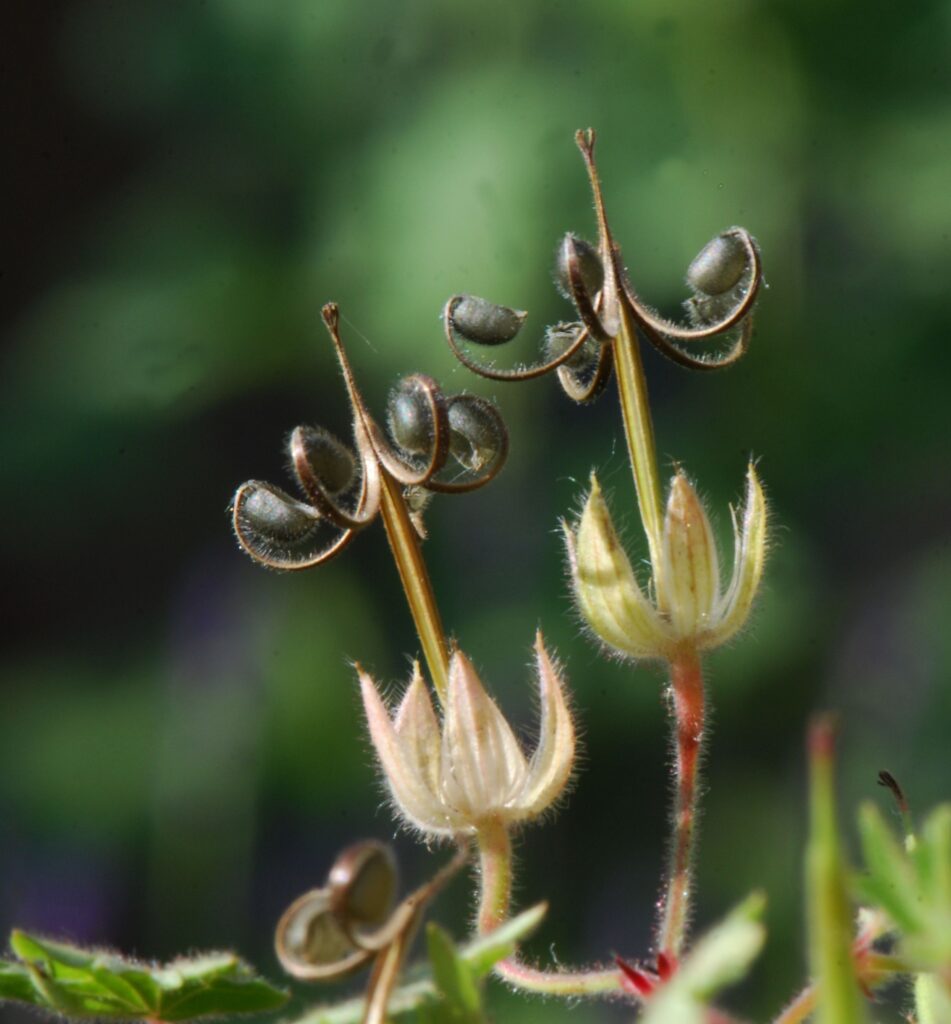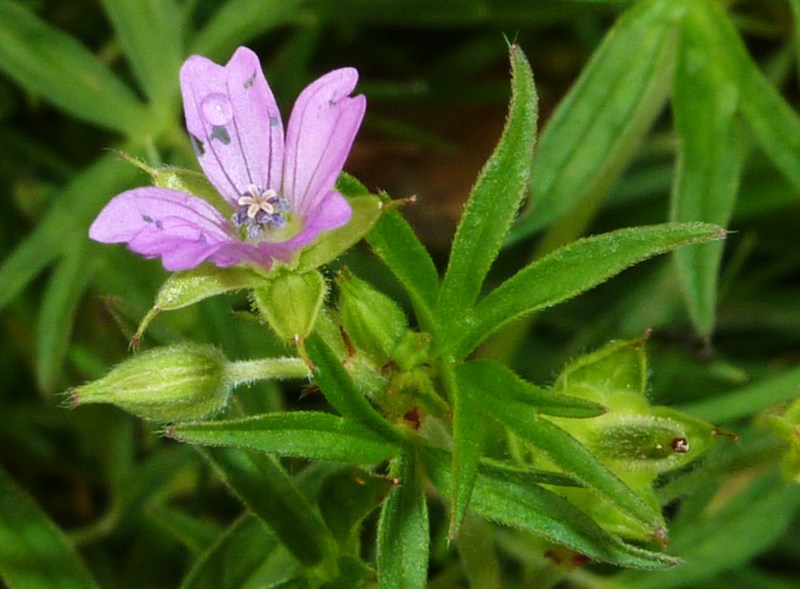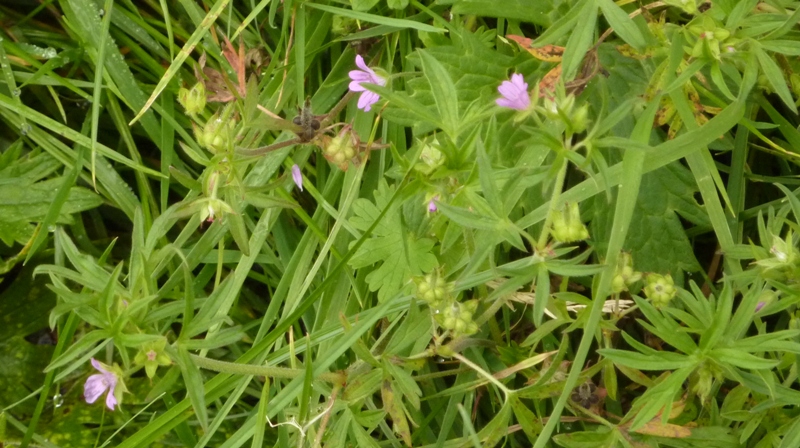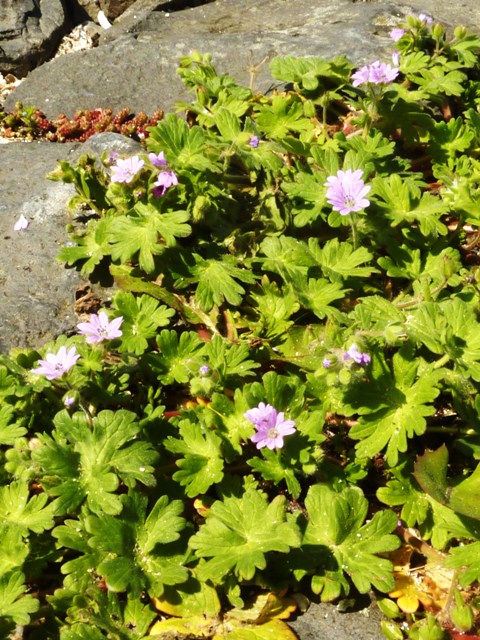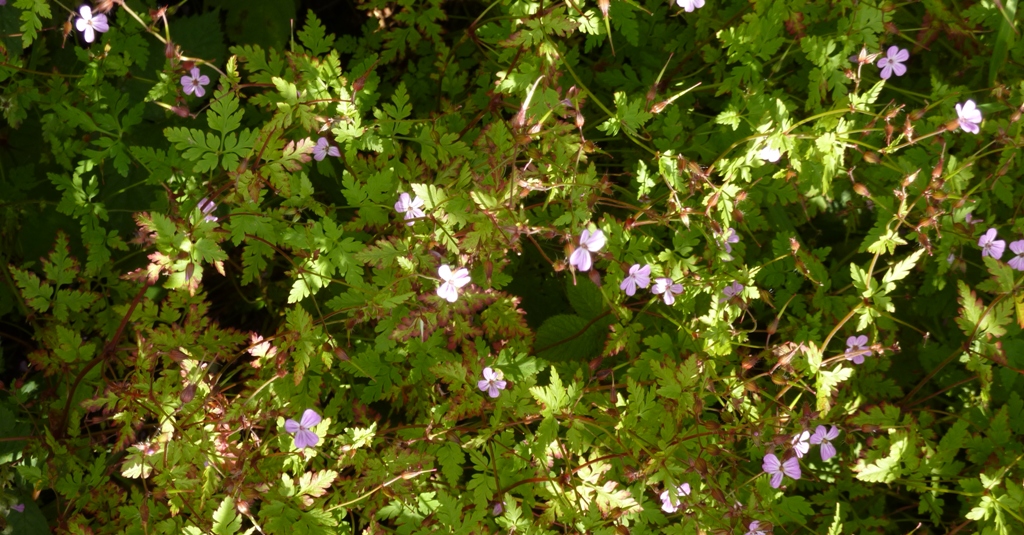
This week another pretty and mostly common native ‘weed’ which can even be useful! It easily could have been called the ‘Geranium’ family instead of Crane’s-bill family as the genus Geranium is its largest member here!
But the genus Erodium, has also several native species on the B.I. and has a fruit similar to a stork’s bill.
So what is the difference in those bird bills to give these plants their common name?
Found this information online from Bird expert Quentin Kalis. “The easiest way is to look at the bill; storks have large heavy bills and cranes have short bills.” Herons have intermediate bills between the two, and you can see pictures of those birds in the link here.
A few native Geranium and Erodium species are ‘useful’ for us people. Various insects find the plants a good food source. Below is the contents of all the species described on the next page and which are native according to Stace.
Contents:
Geranium:
from Subgenus Geranium:
G. rotundifolium or Round-leaved Crane’s-bill
G. sylvaticum or Wood Crane’s-bill
G. pratense or Meadow Crane’s-bill
G. sanguineum or Bloody Crane’s-bill
G. columbinum or Long-Stalk Geranium
G. dissectum or Cut-leaved Crane’s-bill
from Subgenus Robertium: ·
G. pyrenaicum or Hedgerow Crane’s-bill
G. pusillum or Small-flowered Crane’s-bill
G. molle or Dove’s-foot Crane’s-bill·
G. lucidum or Shining Crane’s-bill
G. purpureum or Little Robin·
G. robertianum or Herb-Robert
Erodium spp.
Erodium maritimum or Sea Stork’s-bill
E. moschatum or Musk Stork’s-bill
E. cicutarium or Common Stork’s-bill
E. lebelii or Sticky Stork’s-bill
E. x anaristatum (is a cross of E. cicutarium x E. lebelii)
Most pictures are by Matt Summers unless different stated. The coloured background in the text indicates use. Green is for Wildlife, Ornamental, Edible and other uses. Pink for Medicinal or if the plant is poisonous or troublesome. Blue background for interesting information although I do hope you find it all worthwhile to read!
In Stace’s Flora we find that the Geraniaceae family consist of 3 genera growing in the wild on the British Isles;
- genus Geranium or the Crane’s-bill with a total of 29 species but only 12 are true native species. for ease of identification it is also split into 3 different subgenera: Subgenus Geranium, Subgenus Robertium and Subgenus Erodioidea (no native species with this subgenus here).
- genus Erodium or the Stork’s-bill with 11 species but only 5 are true natives
- genus Monsonia or Dysentery-herbs which are introduced from S. Africa.
(genus) Geranium:
from Subgenus Geranium:
G. rotundifolium or Round-leaved Crane’s-bill
An annual of hedgerows, dry roadside-banks and wall-tops, especially close to the sea, but spreading to roadside verges, rubble heaps, railway ballast and waste ground. It is also a garden and street weed. Colonies may be very persistent, even where the species is confined to weedy habitats.
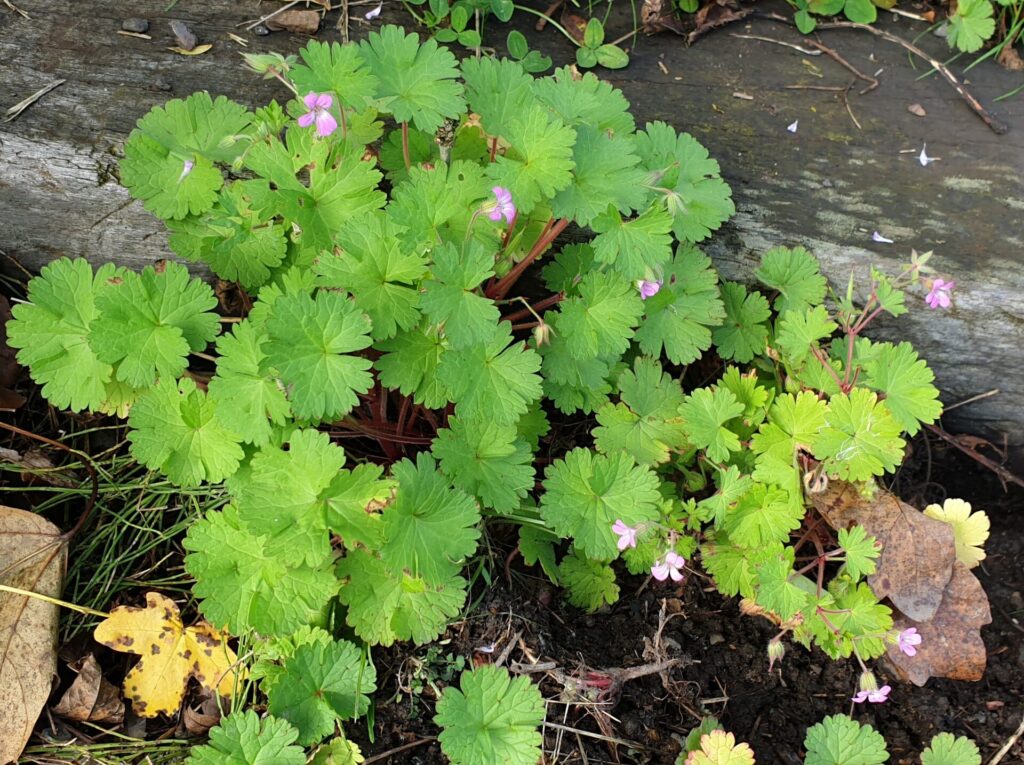
This plant is used as an astringent and diuretic.
G. sylvaticum or Wood Crane’s-bill

A stoutly rhizomatous perennial herb of hay meadows, ungrazed damp woodlands, streamsides and mountain rock ledges, and in many areas a characteristic feature of laneside hedge banks and verges.
This is a useful ornamental plant in a reliably moist, lightly shaded positions, as the name suggests! Various cultivars have been selected, of which ‘Album’ and ‘Mayflower’ have gained the Royal Horticultural Society‘s Award of Garden Merit.
G. pratense or Meadow Crane’s-bill
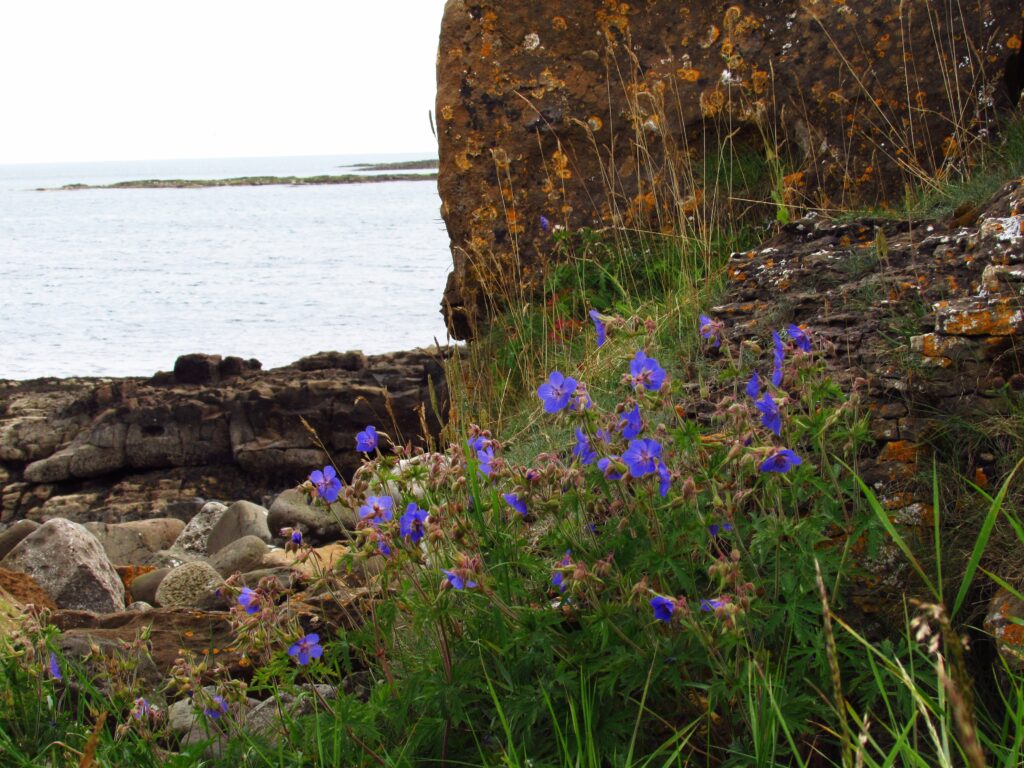
Also a beautiful ornamental border plant. Several cultivars are available for garden use, of which ‘Mrs Kendall Clark‘ and ‘Plenum violaceum‘ have gained the RHS Award of Garden Merit.
G. sanguineum or Bloody Crane’s-bill and here
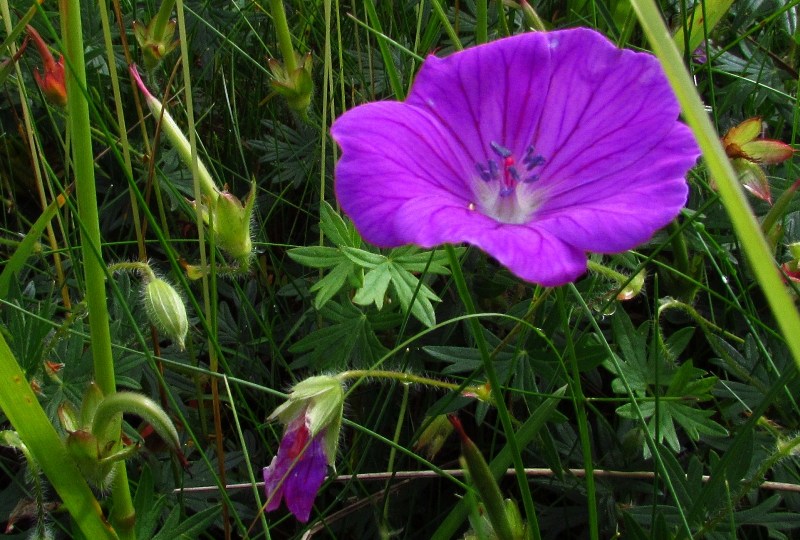
A rhizomatous, perennial herb of base-rich grasslands and scrub, open rocky woodlands, coastal cliffs and stabilised sand dunes; mainly on the coast but also inland on limestone pavements and cliff ledges, and in chalk and limestone grassland. As a native it has a curiously patchy distribution, and is often restricted to localised substrates such as dolerite and serpentine. It also occurs as a garden escape or throw-out on grassy banks, verges, tips and waste ground.
G. sanguineum is cultivated as a garden subject, and a number of different cultivars exist. The following cultivars have gained the RHS Award of Garden Merit:
- ‘Album’
- ‘Ankum’s Pride’
- ’Aviemore’
- ‘Little Bead’
- ‘Shepherd’s Warning’
- G. sanguineum var. striatum
- G. sanguineum var. striatum ‘Splendens’
G. columbinum or Long-Stalk Geranium
An annual of dry grasslands and grassland-scrub mosaics. Its habitats include sand dunes, scrubby cliff slopes, hedge banks, field margins, chalk and limestone downland, railway banks and old quarries. It is usually on calcareous soils, and is often a pioneer on disturbed sites. It favours warm, sheltered, often S.-facing banks and hollows.
This handsome species was recently shown to us on zoom by The Northamptonshire Native Plant-recorder Brian Laney.
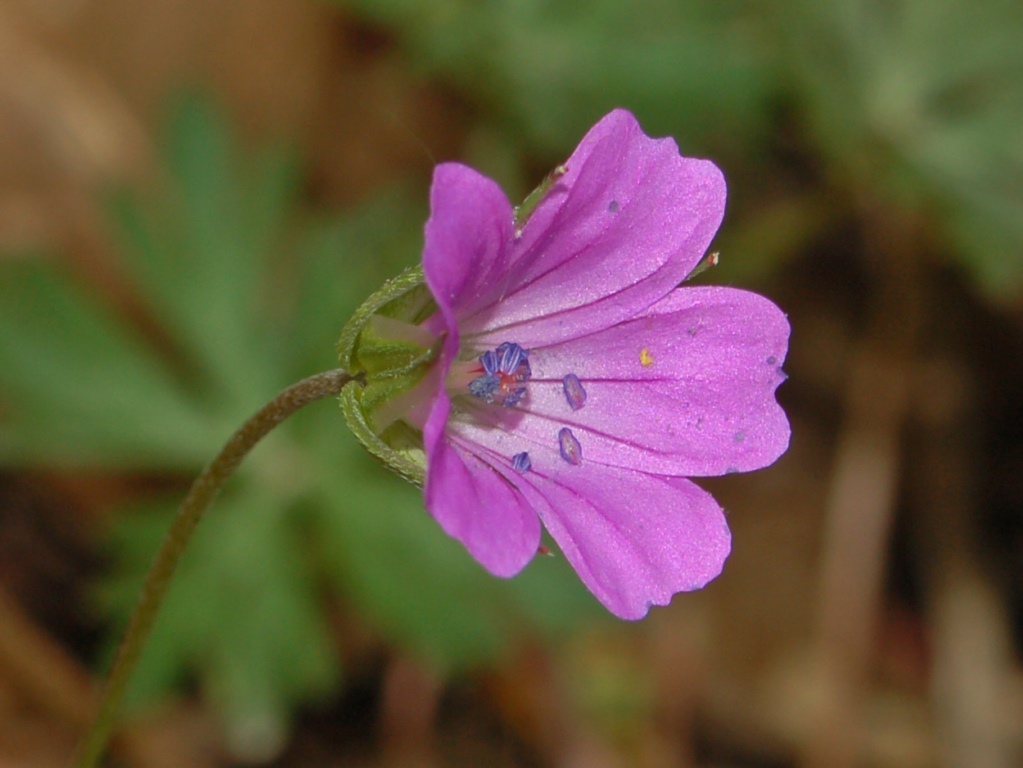
G. dissectum or Cut-leaved Crane’s-bill
An annual of grasslands, hedge banks, waysides and waste ground, and a common weed of flower borders, allotments and arable fields. Archaeophyte.
Geranium dissectum: Extracts of this plant are reported to improve germination rates of Hemp seeds. But who wants to know that I wonder?
from Subgenus Robertium:
G. pyrenaicum or Hedgerow Crane’s-bill
A perennial herb of hedgerows, roadsides, field margins, rough grassy banks and waste places; often found growing close to habitation, and possibly sometimes occurring as a garden escape or throw-out. Neophyte.
Several cultivars are grown such as ‘Isparta’ , ‘Bill Wallis’ and the form albiflorum for example.
G. pusillum or Small-flowered Crane’s-bill
An annual of cultivated land, open summer-droughted grasslands, roadsides and waste places, thriving in well-drained, sandy soils.
G. molle or Dove’s-foot Crane’s-bill
An annual found in a wide array of open habitats, including dry grasslands, rock outcrops, cultivated land, garden lawns, verges and waste ground.
G. molle: Nicholas Culpeper in his herbal of 1652 suggested a variety of uses for G. molle, including the treatment of internal and external injuries. A note was made that the bruised leaf healed external injuries faster. A decoction in wine was said to relieve gout and other joint pains.
G. lucidum or Shining Crane’s-bill or here
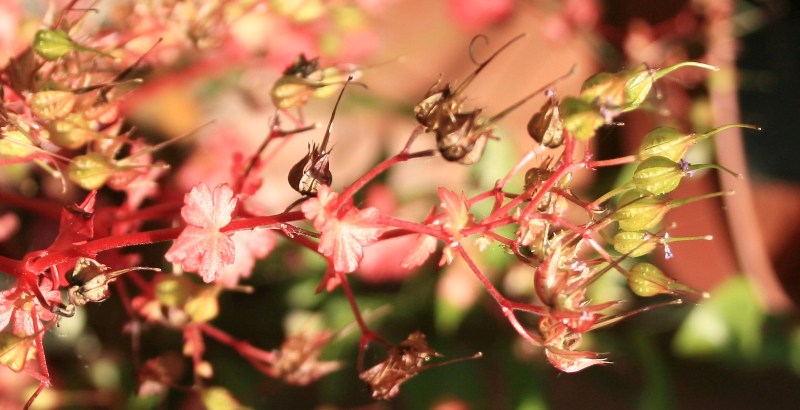
An annual of roadside-banks, rock outcrops and scree, preferring calcareous soils and characteristic of limestone districts. It is widespread in artificial habitats, including mortared walls, churchyards, roadsides, waste ground and railway ballast; also as an escape from gardens.
G. lucidum is a handsome plant, especially when it turns a vivid red in autumn or drought but it has been introduced to North America as a garden plant and in places, particularly the Pacific Northwest, has become naturalised and is viewed as an invasive species and noxious weed.
G. purpureum or Little Robin
Subspecies purpureum is an upright annual in stony or rocky places near the sea, on sheltered cliffs, disused railway lines, and particularly by roads and fields on the earth-and-stone sides of Cornish hedge banks. Subsp. forsteri is a prostrate plant of stabilised areas at the top of shingle beaches.
G. robertianum or Herb-Robert
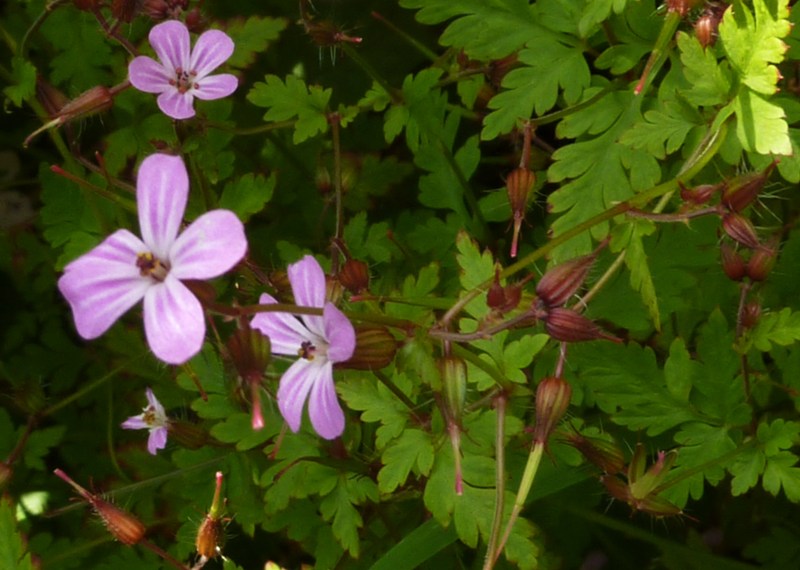
An annual or biennial shade-tolerant herb found on a wide range of soil types, except those that are strongly acidic. Its habitats include woods, hedgerows, walls, shaded banks, limestone pavements, screes and coastal shingle; also in disturbed artificial habitats.
Medicinal Uses:
Geranium robertianum is the only medicinal species of Geranium mentioned by Julian Barker in his Medicinal Flora.
Action: Astringent, haemostatic and styptic as well as a weak diuretic.
Uses: duodenal ulcers, diarrhoea; fistulae; metrorrhagia; Vincent’s angina; stomatitis; sores of Herpes simplex or H. zoster; erysipalas; nosebleeds and leucorrhoea.
Many people can get annoyed with probably the most common crane’s-bill found which is no doubt Geranium robertianum or herb-Robert.
But this plant is most attractive, especially close-up; with its delicate but pungent foliage which goes a beautiful fiery red in cold weather or poor growing conditions. It has delicate magenta star like flowers too. There is a white form I grew from HPS seeds on my allotment last year!
Its only fault is too spread its seeds too enthusiastically which therefore makes it unpopular with some gardeners.
Herb-Robert is a foodplant and nectar-source for many invertebrates including bees, hoverflies and the barred carpet moth.
Have learnt that the common name has been explained as a reference to abbot and herbalist Robert of Molesme. In another account it is said to be named after an ancient association with Robin Goodfellow, a house goblin from English folklore also known as Puck!
Erodium spp.
The genus Erodium has 11 species mentioned in Stace but only 5 are ‘true’ natives.
Erodium maritimum or Sea Stork’s-bill
An annual of trampled or closely-grazed cliff-top grasslands, disturbed sand dunes and gull-infested sea-cliffs, and around coastal settlements on walls and pavements. Inland, it has been recorded from limestone grassland (Somerset), in heathland areas by sandy tracks and gravel workings and, rarely, as an introduction on railway ballast.
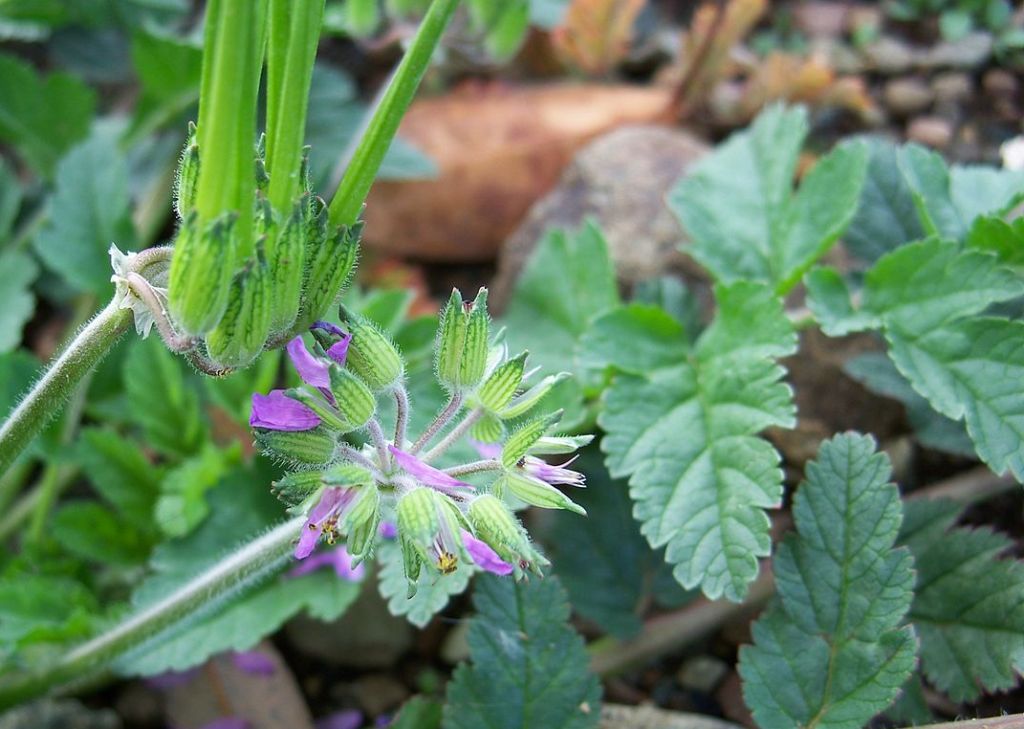
E. moschatum or Musk Stork’s-bill
An annual of barish places near the sea, in disturbed sand dunes, on roadsides, wall-tops, field margins and waste ground. In the Isles of Scilly it is a frequent bulb-field weed. It is recorded inland as a casual, sometimes introduced with wool shoddy. Archaeophyte.
This species has edible, raw or cooked leaves. Can be added to salads or used as a potherb. I found several other interesting uses on a brilliant American website called Eat-the-weeds.
The entire plant can be used as a green dye and does not need a mordant to set the color.
The plant is a febrifuge. It is astringent and a tincture of the plant is used in the treatment of dysentery. Found eight other uses by Eat-the-weeds:
- A leaf tea has been used to induce sweating and is diuretic.
- The leaves were also soaked in bath water to treat rheumatism.
- Plant contains tannin, is astringent and a hemostatic.
- It has been used for uterine and other bleeding
- Roots were eaten by nursing mothers to increase milk flow.
- Externally used as a wash on animal bites and skin infections.
- A poultice of the chewed root has been applied to sores and rashes.
- It is reputed to contain an antidote for strychnine.
E. cicutarium or Common Stork’s-bill
Annuals of well-drained sandy and rocky places, sand dunes, summer-parched grasslands and heaths; they are also found on roadsides, stone walls and railway ballast, and are common wool aliens.
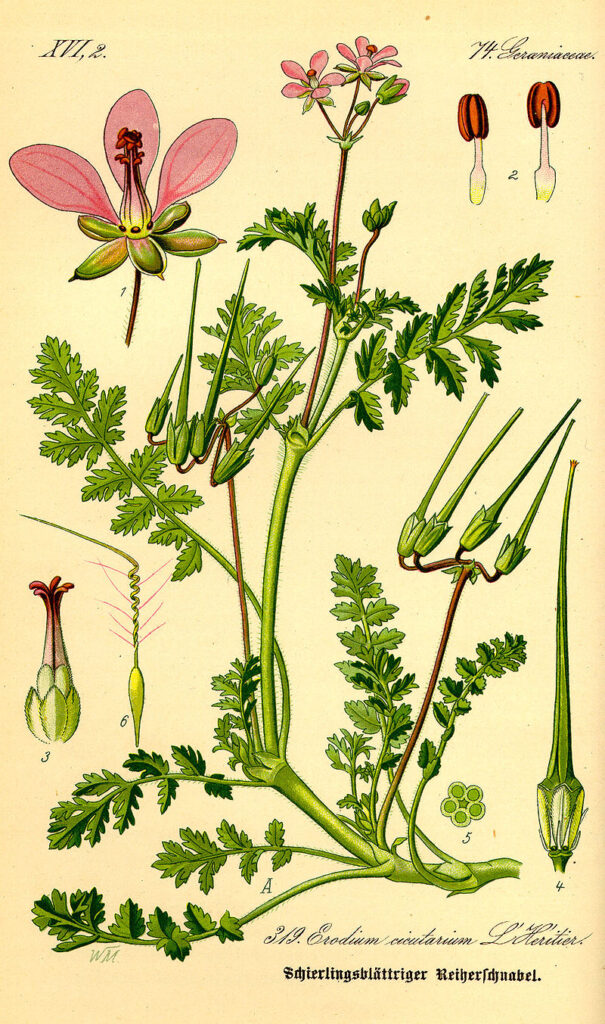
The entire plant is edible with a flavour similar to sharp parsley if picked young. According to John Lovell’s Honey Plants of North America (1926), “the pink flowers are a valuable source of honey (nectar), and also furnish much pollen”.
Among the Zuni people, a poultice of chewed root is applied to sores and rashes and an infusion of the root is taken for stomach ache.
It is a food plant for the larvae of the brown argus butterfly. The seeds of this annual are a species collected by various species of harvester ants.

